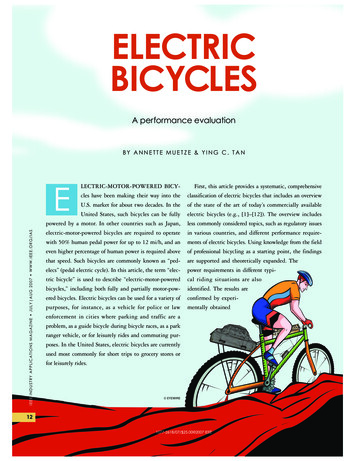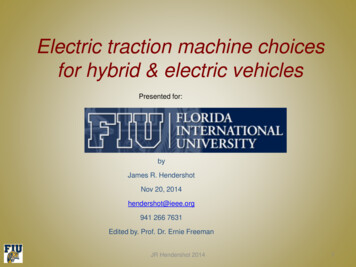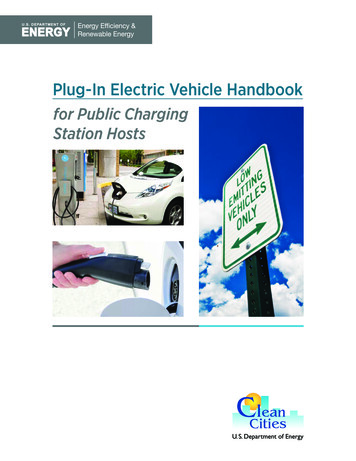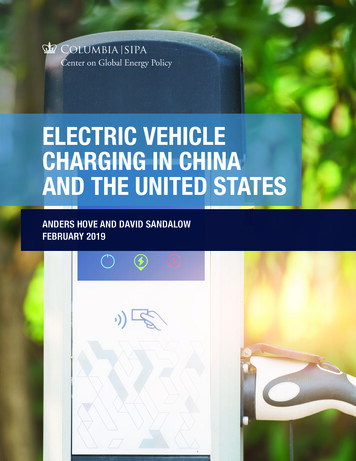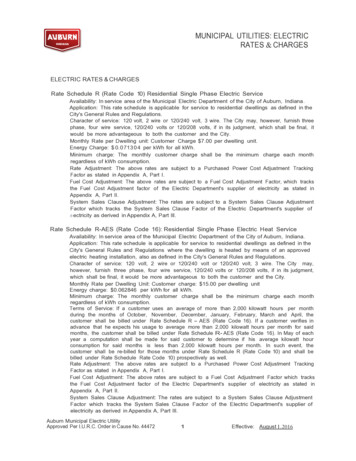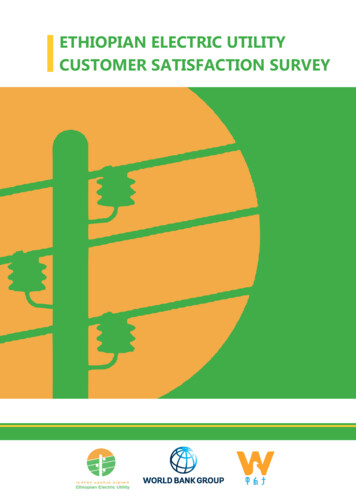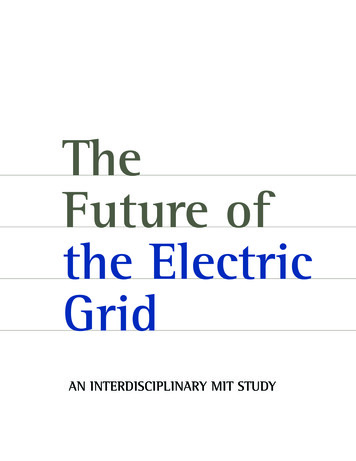
Transcription
TheFuture ofthe ElectricGridAN INTERDISCIPLINARY MIT STUDY
Other Reports in This SeriesThe Future of Nuclear Power (2003)The Future of Geothermal Energy (2006)The Future of Coal (2007)Update to the Future of Nuclear Power (2009)The Future of Natural Gas (2011)The Future of the Nuclear Fuel Cycle (2011)This study can also be viewed online ectric-grid-2011.shtmlCopyright 2011 Massachusetts Institute of Technology. All rights reserved.ISBN 978-0-9828008-6-7iiMIT STUDY ON THE FUTURE OF THE ELECTRIC GRID
Study ParticipantsSTUDY CO-CHAIRSJOHN G. KASSAKIANProfessor of Electrical Engineering andComputer Science, MITFormer Director, MIT Laboratory forElectromagnetic and Electronic SystemsRICHARD SCHMALENSEEHoward W. Johnson Professor ofEconomics and Management, MITFormer John C Head III Dean, MIT SloanSchool of ManagementSTUDY MANAGEMENTGARY DESGROSEILLIERSExecutive DirectorTIMOTHY D. HEIDELResearch DirectorPostdoctoral Associate, MIT Energy InitiativeSTUDY GROUPWILLIAM W. HOGANRaymond Plank Professor of Global Energy PolicyResearch Director, Harvard Electricity Policy Group,Mossavar-Rahmani Center for Business andGovernment, John F. Kennedy Schoolof Government, Harvard UniversityHENRY D. JACOBYWilliam F. Pounds Professor of Management Emeritus,MITJAMES L. KIRTLEYProfessor of Electrical Engineering, MITHARVEY G. MICHAELSResearch Scientist, Department of Urban Studiesand Planning, MITIGNACIO PÉREZ-ARRIAGAProfessor of Electrical EngineeringComillas University, SpainVisiting Professor, Engineering Systems Division, MITKHURRAM AFRIDIAssociate Professor and Werner-von-SiemensChair for Power Electronics, Lahore Universityof Management Sciences, School of Scienceand Engineering, PakistanVisiting Associate Professor of ElectricalEngineering and Computer Science, MITDAVID J. PERREAULTProfessor of Electrical Engineering and ComputerScience, MITAMRO M. FARIDAssistant Professor of Engineering Systems andManagement, Masdar Institute, UAEResearch Affiliate, Technology and DevelopmentProgram, MITGERALD L. WILSONVannevar Bush Professor of Electrical EngineeringEmeritus, MITFormer Dean, MIT School of EngineeringNANCY L. ROSECharles P. Kindleberger Professor of Applied Economics,MITJERROLD M. GROCHOWResearch Affiliate, MIT Energy InitiativeFormer Vice President for Information Servicesand Technology, MITMIT Study on the Future of the Electric Gridiii
STUDENT RESEARCH ASSISTANTSNABI ABUDALDAHWageningen University, The NetherlandsVisiting Student, MITMINJIE CHENElectrical Engineering and Computer Science,MITPEARL E. DONOHOOEngineering Systems Division, MITSAMANTHA J. GUNTERElectrical Engineering and Computer Science,MITP. JORDAN KWOKEngineering Systems Division, MITivMIT STUDY ON THE FUTURE OF THE ELECTRIC GRIDVIVEK A. SAKHRANIEngineering Systems Division, MITJIANKANG WANGElectrical Engineering and Computer Science,MITANDREW WHITAKEREngineering Systems Division, MITXIANG LING YAPHarvard UniversityEngineering Systems Division, MITRICHARD Y. ZHANGElectrical Engineering and Computer Science,MIT
Advisory Committee MembersJ. BENNETT JOHNSTON — CHAIRUnited States Senate (Retired)STEVEN NAUMANNExelon CorporationGEORGE ARNOLDNational Institute of Standards and TechnologyPEDRO PIZARRO AND DAVID MEADSouthern California EdisonLISA M. BARTONAmerican Electric PowerCLAES RYTOFTABB GroupTROY BATTERBERRY ANDELIZABETH GROSSMANMicrosoft CorporationMIGUEL ÁNGEL SÁNCHEZ FORNIÉIberdrola S.A.WILLIAM W. BERRYDominion Resources (Retired)CLARK GELLINGSElectric Power Research InstituteROBERT GILLIGAN AND LARRY SOLLECITOGeneral Electric CompanyLAURA IPSEN AND PAUL DE MARTINICisco SystemsPAUL JOSKOWAlfred P. Sloan FoundationBASEM SARANDAHNexant, Inc.J. CHARLES SMITHUtility Wind Integration GroupSUSAN TIERNEYAnalysis GroupGORDON VAN WELIEISO New EnglandSTEPHEN G. WHITLEYNew York ISOELIZABETH ANNE MOLERFormer Chair of the Federal Energy RegulatoryCommissionMIT Study on the Future of the Electric Gridv
viMIT STUDY ON THE FUTURE OF THE ELECTRIC GRID
Foreword and AcknowledgmentsFor well over a century, electricity has madevital contributions to the growth of the U.S.economy and the quality of American life. TheU.S. electric grid is a remarkable achievement,linking electric generation units reliably andefficiently to millions of residential, commercial, and industrial users of electricity throughmore than six million miles of lines andassociated equipment that are designed andmanaged by more than 3,000 organizations,many of which are in turn regulated by bothfederal and state agencies. While this remarkable system of systems will continue to serve uswell, it will face serious challenges in the nexttwo decades that will demand the intelligentuse of new technologies and the adoption ofmore appropriate regulatory policies.This report aims to provide a comprehensive,objective portrait of the U.S. electric grid andthe challenges and opportunities it is likely toface over the next two decades. It also highlightsa number of areas in which policy changes,focused research and demonstration, and thecollection and sharing of important data canfacilitate meeting the challenges and seizing theopportunities that the grid will face.This study is the sixth in the MIT EnergyInitiative’s “Future of” series. Its predecessorshave shed light on a range of complex andimportant issues involving energy and theenvironment. While the previous studies havefocused on particular technologies and energysupply, our study of the grid necessarilyconsiders many technologies and multipleoverlapping physical and regulatory systems.Because of this breadth, our efforts werefocused on integrating and evaluating existingknowledge rather than performing originalresearch and analysis. In addition, this study’spredecessors focused on implications ofnational policies limiting carbon emissions,while we do not make assumptions regardingfuture carbon policy initiatives. Instead, wemainly consider the implications of a set ofongoing trends and existing policies.We anticipate this report will be of value to awide range of decision makers in industry andgovernment as they guide the grid’s continuingevolution. We have attempted to providethorough discussions of key topics to serve asreferences, to support our findings and recommendations, and to meet the needs of what weexpect will be a diverse audience in terms ofinterest and expertise. Also, for those lessfamiliar with the industry, we include appendices on the grid’s history and technology.Chapter 1 provides an overview of the statusof the grid, the challenges and opportunities itwill face, and our major recommendations. Tofacilitate selective reading, detailed descriptionsof the contents of each section in Chapters 2–9are provided in each chapter’s introduction,and recommendations are collected and brieflydiscussed in each chapter’s final section.The MIT Future of the Electric Grid Studygratefully acknowledges the sponsors of thisstudy: ABB Group, American Electric Power,Bechtel Foundation, Larry Birenbaum, CiscoSystems, Exelon Corporation, GeneralElectric Company, Iberdrola S.A., MicrosoftCorporation, National Institute of Standardsand Technology, and Southern CaliforniaEdison. In addition to providing financialsupport, many of our corporate and governmentsponsors gave us access to staff members whoprovided frequent and detailed informationabout technical and policy issues. We are verygrateful for this cooperation.MIT Study on the Future of the Electric Gridvii
The Advisory Committee members dedicateda significant amount of their time to participatein multiple meetings, read and comment onseveral early drafts of the report, and makeavailable experts from their own organizationsto answer our questions and contribute to thecontent of the report. We would especially liketo acknowledge the efficient conduct ofAdvisory Committee meetings under the ableand experienced direction of Senator J. BennettJohnston, Chair.In addition to all of the valuable contributionsfrom the sponsors, the Advisory Committee,and other members of their respective organizations, research on this project also benefitedfrom individual conversations with LaurenAzar, Andrew Bochman, Paul Centolella, MattDinsmore, Joseph Eto, Emily Fisher, RichardO’Neill, Arun Phadke, a number of individualsin the Brattle Group and National Grid, andcountless others who we interacted with atconferences and industry events.This study was initiated and performed withinthe MIT Energy Initiative (MITei). The Directorof MITei, Professor Ernest J. Moniz, selected theCo-Chairs of the study, helped identify membersof the Advisory Committee, and helped engagethe study sponsors. MITei staff providedadministrative and financial managementassistance to this project. In addition, we wouldlike to acknowledge the important contributionsof Melanie Kenderdine, Joseph Hezir, RebeccaMarshall-Howarth, Patricia Connell, NatalieLiang, and Justin Daniels.viiiMIT STUDY ON THE FUTURE OF THE ELECTRIC GRIDFinally, we would like to thank Sarah Aldy forediting this document and maintaining herpatience with our team through many complicated iterations. Any errors in the final document are the responsibility of the study groupand not the editor or anyone else.The final report represents the opinions of thestudy group, which is solely responsible for itscontent. The advisory committee and sponsorsare not responsible for, and do not necessarilyendorse, the findings and recommendationscontained within this report.
Table of ContentsxiAbstract1Chapter 1: Challenges, Opportunities, and Major Recommendations31537710912721.1 Today’s Electric Grid111.2 Challenges and Opportunities211.3 Major Recommendations281.4 Concluding RemarksChapter 2: Enhancing the Transmission Network and System Operations322.1 The Transmission Network and System Operations362.2 Preventing Blackouts392.3 Increasing Transmission Capacity462.4 Improving System Operations492.5 Conclusions and RecommendationsChapter 3: Integration of Variable Energy Resources553.1 Characteristics of Variable Energy Resources563.2 Variable Energy Resources and the Cost of Reserves643.3 Ensuring Adequate System Flexibility693.4 Interconnecting Variable Energy Resources713.5 Conclusions and RecommendationsChapter 4: Transmission Expansion794.1 Transmission Development in the U.S.834.2 Transmission Planning884.3 Transmission Cost Allocation974.4 Siting New Transmission Capacity1014.5 Conclusions and RecommendationsChapter 5: The Impact of Distributed Generation and Electric Vehicles1095.1 Distributed Generation1165.2 Electric Vehicles1225.3 Conclusions and RecommendationsChapter 6: Enhancing the Distribution System1286.1 Opportunities in Distribution System Operation1326.2 Advanced Metering for the Distribution System1376.3 Pilot Programs and Deployment Challenges1396.4 Conclusions and RecommendationMIT Study on the Future of the Electric Gridix
143175197Chapter 7: Engaging Electricity Demand1457.1 Why Engage Demand?1487.2 Demand Response Programs Today1567.3 Predicting the Benefits of Increased Demand Engagement1617.4 Reducing Residential Energy Consumption1647.5 Expanding Demand Engagement: Findings1677.6 Conclusions and RecommendationsChapter 8: Utility Regulation1768.1 Regulatory Objectives and Processes1798.2 Growing Challenges for Regulatory Policy1858.3 How Should Policy Respond?1938.4 Conclusions and RecommendationsChapter 9: Data Communications, Cybersecurity, and Information Privacy1999.1 Grid Data Communications2089.2 Cybersecurity of the Electric Grid2199.3 Information Privacy and Security2279.4 Conclusions and RecommendationsAppendices235243xAppendix A: A Brief History of the U.S. Grid235A.1 Beyond Municipal Boundaries236A.2 A Federal Role Emerges238A.3 Interconnection and CompetitionAppendix B: Electric Power System Basics243B.1 Introduction243B.2 Fundamentals of Electric Power247B.3 Structure of the Electric Power System254B.4 Operation of the Electric Power System258B.5 Wholesale Electricity Markets259B.6 Power System Planning261Glossary267Acronyms and AbbreviationsMIT STUDY ON THE FUTURE OF THE ELECTRIC GRID
AbstractThe U.S. electric grid is a vast physical andhuman network connecting thousands ofelectricity generators to millions of consumers—a linked system of public and private enterprisesoperating within a web of government institutions: federal, regional, state, and municipal.The grid will face a number of serious challengesover the next two decades, while new technologies also present valuable opportunities formeeting these challenges. A failure to realizethese opportunities or meet these challengescould result in degraded reliability, significantlyincreased costs, and a failure to achieve severalpublic policy goals.This report, the fifth in the MIT EnergyInitiative’s Future of series, aims to providea comprehensive, objective portrait of the U.S.electric grid and the identification and analysisof areas in which intelligent policy changes,focused research, and data development andsharing can contribute to meeting the challenges the grid is facing. It reflects a focus onintegrating and evaluating existing knowledgerather than performing original research. Wehope it will be of value to decision makers inindustry and in all levels of government as theyguide the grid’s necessary evolution.One of the most important emerging challengesfacing the grid is the need to incorporate morerenewable generation in response to policyinitiatives at both state and federal levels. Muchof this capacity will rely on either solar or windpower and will accordingly produce output thatis variable over time and imperfectly predictable,making it harder for system operators to matchgeneration and load at every instant. Utilizingthe best resource locations will require manyrenewable generators to be located far fromexisting load centers and will thus necessitateexpansion of the transmission system, often viaunusually long transmission lines. Currentplanning processes, cost-allocation procedures,and siting regimes will need to be changed tofacilitate this expansion. In addition, increasedpenetration of renewable distributed generation will pose challenges for the design andoperation of distribution systems, and mayraise costs for many consumers.Increased penetration of electric vehicles andother ongoing changes in electricity demandwill, if measures are not taken, increase theratio of peak to average demand and thusfurther reduce capacity utilization and raiserates. Changes in retail pricing policies, enabledby new metering technology, could help tomitigate this problem. Increased penetrationof distributed generation will pose challengesfor the design and operation of distributionsystems. New regulatory approaches may berequired to encourage the adoption of innovative network technologies.Opportunities for improving the functioningand reliability of the grid arise from technological developments in sensing, communications, control, and power electronics. Thesetechnologies can enhance efficiency andreliability, increase capacity utilization, enablemore rapid response to remediate contingencies,and increase flexibility in controlling power flowson transmission lines. If properly deployed andaccompanied by appropriate policies, they candeal effectively with some of the challengesdescribed above. They can facilitate the integration of large volumes of renewable and distributed generation, provide greater visibility of theinstantaneous state of the grid, and make possiblethe engagement of demand as a resource.MIT Study on the Future of the Electric Gridxi
All these new technologies involve increaseddata communication, and thus they raiseimportant issues of standardization, cybersecurity, and privacy.Decision makers in government and industryhave taken important actions in recent years toguide the evolution of the U.S. electric powersystem to address the challenges and opportunities noted above. Yet the diversity of ownership and regulatory structures within the U.S.grid complicates policy-making, and a numberof institutional, regulatory, and technicalimpediments remain that require action.Our main recommendations can be brieflysummarized as follows:s 4O FACILITATE THE INTEGRATION OF REMOTErenewables, the Federal Energy RegulatoryCommission should be granted enhancedauthority to site major transmission facilitiesthat cross state lines.s 4O COPE MORE EFFECTIVELY WITH INCREASINGcybersecurity threats, a single federal agencyshould be given responsibility for cybersecurity preparedness, response, and recoveryacross the entire electric power sector,including both bulk power and distributionsystems.s 4O IMPROVE THE GRID S EFlCIENCY AND LOWERrates, utilities with advanced meteringtechnology should begin a transition topricing regimes in which customers pay ratesthat reflect the time-varying costs ofsupplying power.xiiMIT STUDY ON THE FUTURE OF THE ELECTRIC GRIDs 4O IMPROVE UTILITIES AND THEIR CUSTOMERS incentives related to distributed generationand energy conservation, utilities shouldrecover fixed network costs through customercharges that do not vary with the volume ofelectricity consumption.s 4O MAKE EFFECTIVE USE OF NEW TECHNOLOGIESthe electric power industry should fundincreased research and development inseveral key areas, including computationaltools for bulk power system operation,methods for wide-area transmission planning,procedures for response to and recovery fromcyberattacks, and models of consumerresponse to real-time pricing.s 4O IMPROVE DECISION MAKING IN AN INCREASingly complex and dynamic environment,more detailed data should be compiled andshared, including information on the bulkpower system, comprehensive results from“smart grid” demonstration projects, andstandardized metrics of utility cost andperformance.
Chapter 1: Challenges, Opportunities,and Major RecommendationsThis chapter gives an overview of the study and introduces our major findings and recommendations.Section 1.1 provides a brief description of the grid’s current structure and performance, which serve asinitial conditions for our analysis. (Readers may consult Appendix A for a brief history of the U.S. gridand Appendix B for additional information on the technical operation of electric power systems.)Section 1.2 then outlines challenges and opportunities that the grid will confront over the nexttwo decades: incorporating variable energy sources like wind and solar; handling the charging ofelectric vehicles; adjusting distribution systems to accommodate small-scale, distributed electricgenerators; meeting emerging workforce needs; making the best use of new technologies toensure reliability and efficiency under changing conditions; and responding to issues presented bythe vast increase of data communications within the grid. Along the way some of the study’s keyfindings are summarized.Section 1.3 then presents the major recommendations that flow from these concerns, organized byarea of industry and government policy response: the transmission system, the distribution system,cybersecurity and privacy, research and development, and the need for improved datadevelopment and sharing of information. Section 1.4 concludes with brief remarks about the levelof urgency attached to these issues.Hailed as the “supreme engineering achievement of the 20th century” by the NationalAcademy of Engineering,1 the U.S. electricpower grid serves more than 143 millionresidential, commercial, and industrialcustomers 2 through more than 6 million milesof transmission and distribution lines ownedby more than 3,000 highly diverse investorowned, government-owned, and cooperativeenterprises.3 In 2009, electric generationconsumed 41% of the nation’s primaryenergy—up from 14% in 1949—underscoringthe great and growing national importance ofthe grid’s efficiency and reliability.4The electric power system is composed offour interacting physical elements: energygeneration, high-voltage transmission, lowervoltage distribution, and energy consumption,or load. Two less tangible elements are alsoimportant: the operational systems that protectand control the physical elements, and theiregulatory and governance structures thatshape the system’s evolution. The term “grid”as used in this report refers not only to thephysical transmission and distribution systemsthat link generators to ultimate loads but alsothe associated operational, regulatory, andgovernance structures. Appendix A brieflysummarizes the history of the U.S. grid.This study considers the evolution of theU.S. electric grid over the next two decades—a period long enough to permit significantchange but short enough to make it unlikelythat unforeseenThis study considers the evolutiontechnologies willof the U.S. electric grid over thehave significantimpacts on thenext two decades.system.i Even thoughthis is likely to be a period of slow growth inthe U.S. demand for electricity by historicalstandards, public policies and a variety oftechnological and economic changes will alterAn excellent brief overview of many of the issues considered in this report is provided by P. L. Joskow,“Creating a Smarter U.S. Electricity Grid,” Journal of Economic Perspectives, forthcoming.Chapter 1: Challenges, Opportunities, and Major Recommendations1
both the demand for and supply of electricityin challenging ways. If regulatory policies andthe technologies employed in the grid do notchange, it is likely to be difficult to maintainacceptable reliability and electric rates.Technologies exist that can meet these challenges effectively, but only if a number ofregulatory policies are changed, necessaryThe U.S. does not have a comprehensive nationalelectricity policy, and regulatory regimes differsubstantially among states.research and development is performed, andimportant data are compiled and shared.Several features of electric power systems arefundamental to their structure and operation:s )T IS GENERALLY NOT ECONOMICALLY FEASIBLE TOstore electricity in bulk. The widespreaddeployment of new storage technologies and/or high penetrations of electric vehicles maysomeday change this, but these developmentsare unlikely before 2030.s )T FOLLOWS THAT ELECTRIC POWER SYSTEMS MUSTvary the supply of electricity to meet minuteto-minute changes in demand and in theoutput of variable energy sources such aswind and solar generators. Power systemsmust be built with enough capacity to meetexpected peak demand with some excesscapacity for safety.s %LECTRICITY mOWS THROUGH MANY TRANSMISSIONpaths from generators to customers, andindividual flows cannot be controlled withprecision.s !N ELECTRIC GRID IS A NATURAL MONOPOLY it would be prohibitively expensive to havemultiple overlapping grids in any region.ii2s 4HE NEED TO MAINTAIN INSTANTANEOUS BALANCEof supply and demand, limits on transmission line capacities, and other features requirecentral coordination of short-term systemoperations.iiThis chapter assumes essentially no additionalknowledge of the workings of electric powersystems, but some parts of later chapters may behard to understand without more background.Readers who would like more background orencounter material they find difficult are urgedto consult Appendix B.1.1 TODAY’S ELECTRIC GRIDIn natural gas, trucking, railroads, airlines, andtelecommunications—industries with a historyof deep and ongoing government involvement—federal policy was substantially reformed after1970 to reflect market realities. In contrast,despite dramatic changes in the electric powersector, federal policies established in the 1930sand even earlier still play a central role in thatsector. The federal government primarily hasadded new policies on top of old ones, unlikethe European Union and many other nationsthat have adopted comprehensive new structures based on competitive wholesale and retailelectricity markets and centrally managednetworks subject to incentive-based regulation.In this section, we first discuss the organizationof the U.S. electric power industry. Even thoughstate boundaries do not affect the flow ofelectricity and thus have no natural role in thedesign or operation of the electric power sector,state regulators retain considerable authority.The U.S. does not have a comprehensivenational electricity policy, and regulatoryregimes differ substantially among states.As we discuss in later chapters, this last requirement has implications for many policies, including the roleand design of competitive electricity markets.5MIT STUDY ON THE FUTURE OF THE ELECTRIC GRID
The result is substantial regional differences.Organized wholesale markets for power arecentral in some areas and nonexistent in others.Subsidies of various sorts for public andcooperative entities are important in someregions but not at all in others.We then turn to a discussion of the industry’sperformance. The industry has done reasonablywell relative to available international benchmarks, despite working within a policy regimenot conducive to efficiency. Because the grid iscurrently functioning well, however, adequatesupport for fundamental policy reform may beunlikely to emerge in the near term. Thus forthe most part we take today’s policy regime asgiven, but, as Section 1.3 makes clear, we believethat some policy changes are necessary toprevent a deterioration of the grid’s performance in light of emerging challenges.StructureAt the highest level, the electric power systemof the continental U.S. consists of threeindependently synchronized grids: the EasternInterconnection, the Western Interconnection,and the Electric Reliability Council of Texas(ERCOT). They are linked by only a fewlow-capacity direct current (dc) lines. Thesethree grids, shown in Figure 1.1, account for73%, 19%, and 8%, respectively, of U.S. electricity sales.6For a variety of reasons, discussion of whichare beyond the scope of this study, organizedwholesale markets do not exist in large parts ofthe nation, despite national policy supportingcompetitive wholesale markets with open,Figure 1.1 Interconnections of the North American Electric GridSource: U.S. Department of Energy, sandMedia/NERC Interconnection 1A.pdf.Chapter 1: Challenges, Opportunities, and Major Recommendations3
Figure 1.2 Regions with Organized Electricity MarketsSource: ISO/RTO Council, http://www.isorto.org. Copyright ISO/RTO Council, all rights reserved.non-discriminatory access to transmissionsystems (see Figure 1.2). Nonetheless, thispolicy has major implications for the transmission grid. Where it has been implemented, ithas led to organized markets with importantcommon elements.Figure 1.2 shows the geographic scope oforganized wholesale electricity markets, whichare operated by Independent System Operators(ISOs) or Regional Transmission Organizations(RTOs) that do not own generators or serveretail customers. These markets now covertwo-thirds of the U.S. population and meetabout two-thirds of U.S. demand. Box 1.1provides an overview of the operation of thesemarkets. In the Southeast, the traditionalvertically integrated utility model is dominant,while in the West, particularly the PacificNorthwest, federal, municipally owned, andcooperative enterprises play an important rolein the industry.Within these broad areas are 107 so-calledbalancing authorities, shown in Figure 1.3,4MIT STUDY ON THE FUTURE OF THE ELECTRIC GRIDwhich are responsible for balancing the supplyand demand for power in real time in specifiedareas. A glance at this map makes plain thestrong influence of history. New York, NewEngland, and Texas are each tightly integratedand have one balancing authority each, whileArkansas and Arizona each have eight andFlorida has eleven. These differences plainlydo not reflect differences in levels of supply ordemand or in system complexity.Physically, the U.S. electric grid currentlyconsists of approximately 170,000 miles ofhigh-voltage (above 200 kilovolts or kV) electrictransmission lines and associated equipment,7and almost 6 million miles of lower-voltagedistribution lines.8 These include approximately2,400 miles of 765 kV alternating current (ac)lines, the highest voltage lines in operation inthe U.S., and more than 3,000 miles of 500 kVdc lines.9 Several hundred entities currentlyown parts of the transmission or bulk powersystem.10 Investor-owned utilities own about66% of the system, and federal enterprises own14%. The rest is divided among other publicly
BOX 1.1 WHOLESALE ELECTRICITY MARKETSIn those areas of the country with wholesaleelectricity markets, the ISO or RTO functionsas both the operator of the system and thefinancial exchange for wholesale energy sales.Selling wholesale electric energy begins witha bidding process whereby generators offeran amount of energy (MWh) for sale duringspecific periods of the next day at a specificprice ( /MWh). These offers are arranged bythe ISO/RTO in ascending order called the“bid stack” and the generators are dispatched(told to generate) in this order until generationmatches load. All the generators that aredispatched receive the same compensationcalled the “clearing price”—the offer of the lastgenerator dispatched. The actual process ismore complicated than this simple explanation,incorporating such parameters as the timerequired to start the generator, out-ofeconomic-order dispatch due to congestion orreliability concerns, and security constraints.Some base-load generators, such as nuclearplants, are costly to shut down or bring back online, and will offer their energy at a price of zeroto ensure that they are always dispatched. Insome cases of very light load these generatorsmay offer their energy at a negative price toguarantee they remain on line since the cost ofstopping and starting outweighs the negativeenergy price. Consequently the cost of wholesaleenergy can swing wildly during a day—fromnear zero to near 1,000/MWh depending onl
Vannevar Bush Professor of Electrical Engineering Emeritus, MIT Former Dean, MIT School of Engineering. iv MIT STUDY ON THE FUTURE OF THE ELECTRIC GRID STUDENT RESEARCH ASSISTAN TS . MIT Study on the Future of the Electric Grid vii Foreword and Acknowledgments For well over a century, electricity has made .






